The ultimate goal of Yoga is not to become the bendiest poser on instagram, as seems to be a growing ambition, but rather it is to move with Freedom and be liberated from suffering. Once we are introduced to Yoga, a journey unfolds and if we do it with authentic longing for this Freedom the journey will help us to find health and wholeness by identifying the obstacles and blockages that prevent us from reaching this potential. The Yoga tradition provides us with a very handy map to find our way through the complexities of who we are. This map of our Being is known as the Panca Maya or more commonly referred to as the Koshas. .
In our modern western times the primary model for finding health has been to treat isolated parts of the body and mind with band aids, drugs and surgery. This sense of separate or disconnected parts can be limiting.
In Yoga we start from a place of Wholeness and look at ourselves as a complex structure of interwoven layers. The ancient Vedic text, the Taittya Upanishad describes this as the Pancamaya Model. Panca means five. ‘Maya’ describes aspects or sheaths of the human structure that are pervading yet co-existing. So each one affects and is in relationship with the others. They can be seen as a map that is guiding us on the journey to centre and finding our true Self. These layers could be viewed as a frequency in the body that goes from gross to subtle – from that which one can see and grasp to that which is invisible and ungraspable.
Annamaya – physical body – that which is nourished by food
Pranamaya – energy body – that which is nourished by life force
Manomaya – body of feeling and emotion – that which reacts
Vijnanamaya – body of belief – our behaviors, patterns and conditions
Anandamaya – body of bliss – unconditional love which is beyond any boundaries
The first 4 ‘maya’ are in constant flux. The 5th is unchanging but often hidden by the first four. If we can find stability and stillness on a physical, energetic, emotional and mind level, the more reliable body of bliss will become a part of our daily awareness.
The Taittirya Upanishad uses the metaphor of a bird to describe each layer. In Sanskrit the word for bird is khaga. ‘Kha’ is the root word for space and ‘ga’ means to move. So ‘Khaga’ describes a bird as the one who moves in space, beyond boundaries. This reminds us of the key purpose of yoga: liberation – free from boundaries and restrictions.
As we strive for this goal of freedom we follow the journey of paying attention to all that is arising. In order to maintain a sense of centre and balance in our lives we must work with all of these layers of our being.
I have learnt and experienced these layers from a number of teachers coming from different traditions. In the Krishnamacharya lineage they use only the word ‘Maya’ to describe the sheaths however in other traditions they are also commonly referred to as the Koshas. (I like the word Kosha and so will often refer to them as that in my classes.)
As we come to understand and connect with all of our Koshas we can begin to see what is really going on and welcome and attend to all of our visitors be they positive or negative. If we tune in every day to our physical, energetic, mental, emotional and bliss body to see what’s going we can begin to make appropriate actions and supportive responses in our daily lives. It’s like checking for our own personal weather report and then dressing for the day accordingly. So if it’s a cold rainy day I’m not going to walk into it wearing my beach gear right?! I’ll need to find my raincoat and wrap up warm to stay well and feel protected.
I’ll follow up with a blog for each layer of being in this model.
I begin many classes and practices with a Kosha ‘Check-in’. This allows a moment to really feel what’s arising and practice appropriately. By including this at the begining of practice you will become more sensitized to the felt sense of each Koshic layer of your being.
You can use this ‘Kosha Check-in’ audio clip to connect with your layers right now. You may be guided by my voice initially but as you become more familiar with the sequence, sensations and curiosity you will be able to do this as an internal practice for your Self.
Feel free to leave a comment below sharing any Koshic discoveries you have made today! x

